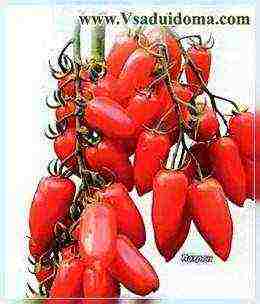Content
- 1 Raspberry: a description of the appearance and qualities
- 2 Raspberries from June to October - how much progress has come
- 3 Domestic and foreign raspberries - the best varieties for a garden plot
- 4 Raspberry seedlings quality standards
- 5 A medicine and a treat for the flu and cold season is the main advantage of raspberry berries
- 6 Apricot
- 7 Indian summer
- 8 Bryansk jubilee
- 9 Hercules
- 10 Eurasia
- 11 Yellow giant
- 12 Golden domes
- 13 Polka
- 14 Ruby necklace
- 15 Elegant
- 16 Early raspberry varieties
- 17 Mid-season varieties
- 18 Late ripening varieties
- 19 Repaired plants
- 20 Yellow raspberry
- 21 Black varieties
You can meet raspberries in any forest where it grows in its primeval form. It is believed that wild berries are much healthier than cultivated ones. The chemical composition is saturated not only with nutrients, but also with useful substances. The healing and tonic properties of the fruits, leaves and shoots of the plant have been known since ancient times. Fresh and dried, they were used to brew a drink that increases the body's resistance, adds strength, and heals a chronic cough.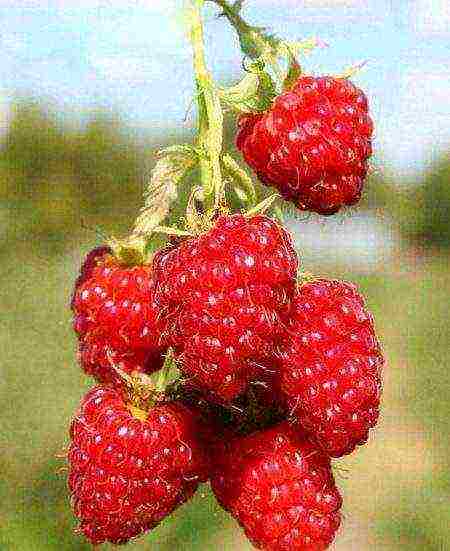
Raspberry: a description of the appearance and qualities
The name of the plant comes from the root of the word "small". The appearance of the shrub has not changed for centuries.
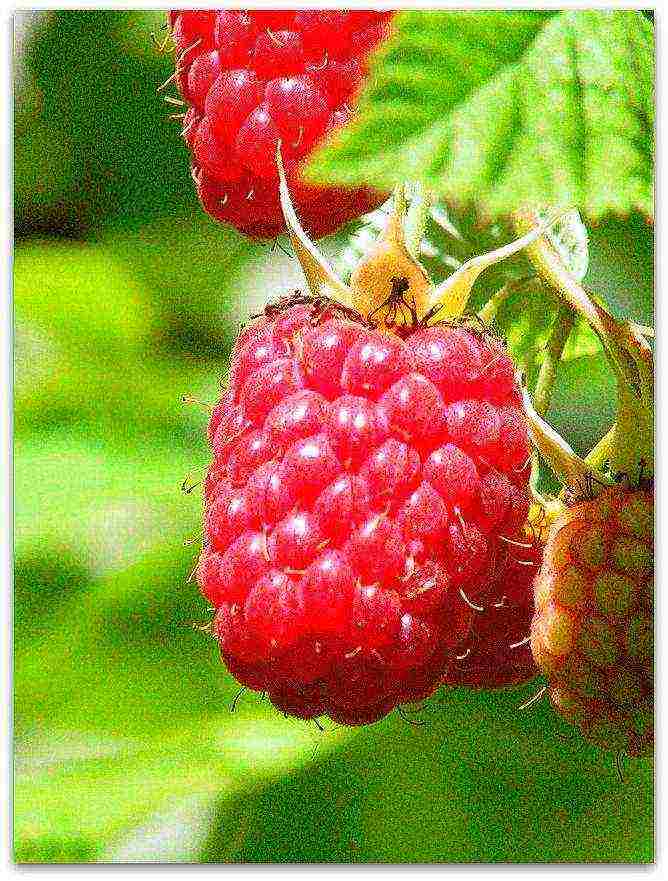 Erect shoots grow from the surface of the earth. Several stems are formed from one root. First-year shoots are herbaceous, flexible, green. From the second year they grow stiff, acquire a reddish-brown hue, acquire a different number of thorns.
Erect shoots grow from the surface of the earth. Several stems are formed from one root. First-year shoots are herbaceous, flexible, green. From the second year they grow stiff, acquire a reddish-brown hue, acquire a different number of thorns.- The bush leaves are complex, five-toed. On the one hand - glossy green, on the back - light, slightly rough. The surface of the leaf plate is slightly wrinkled, the edges are lowered down.
- The berries of a raspberry bush are a drupe, a complex fruit. The shape is round or conical. As it ripens, the color changes from greenish-white to red, maroon, lilac.
Wild raspberries are most often red or orange-yellow in color. They are much smaller in size than varietal. The weight of wild berries is about 2-2.5 grams. After a breakthrough in the field of selection, not every adult, let alone a child, will be able to answer the question of what kind of raspberry is. Modern cultural varieties include all shades of scarlet, yellow, pink, black.
With the development of science, raspberry varieties appeared that favorably differ from their forest counterparts. The improvement in taste and the race for the harvest cost the culture the loss of such qualities as frost resistance and resistance to viral diseases. The result of scientific research has led to the fact that new early raspberry varieties begin to ripen at the end of June. And modern "long-playing", as the people say, varieties sometimes bear fruit before the first snow. And others leave for the winter with fruits on the branches.
Raspberries from June to October - how much progress has come
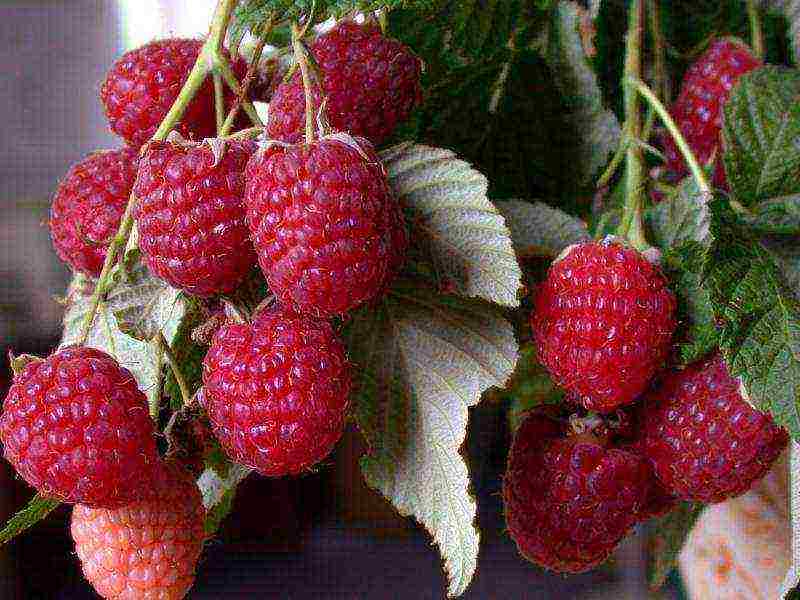 Repaired and semi-renovated varieties of raspberries were bred by breeders relatively recently. Thanks to modern technologies, the varieties have excellent immunity to most crop diseases: anthracnose, purple spot, decay, raspberry mite. Most varieties are frost-resistant, unpretentious to care for. They tolerate drought and form an ovary in all conditions.With the overwhelming number of positive characteristics, early remontant varieties of raspberries have a significant drawback - the plants lose their yield after 2-3 years of active fruiting. Therefore, they need to periodically replace obsolete bushes with new ones.
Repaired and semi-renovated varieties of raspberries were bred by breeders relatively recently. Thanks to modern technologies, the varieties have excellent immunity to most crop diseases: anthracnose, purple spot, decay, raspberry mite. Most varieties are frost-resistant, unpretentious to care for. They tolerate drought and form an ovary in all conditions.With the overwhelming number of positive characteristics, early remontant varieties of raspberries have a significant drawback - the plants lose their yield after 2-3 years of active fruiting. Therefore, they need to periodically replace obsolete bushes with new ones.
 Austrian early - dessert with raspberry flavor
Austrian early - dessert with raspberry flavor
The Austrian early raspberry variety pleases with beautiful, conical berries from the beginning of July to September. The taste is sweet, with a slight sourness. Very strong aroma. Berries average about 4 grams, yield 2.5 - 4 kg. The plant is medium-sized, 2.5 meters tall. Requires anchoring on a support. Shows signs of renovation. The highest yield is demonstrated during the first two years. In the future, the number of fruits from the bush is sharply reduced, it is necessary to update the plantings. Frost-resistant plant, excellent resistance to crop diseases.
For industrial and horticultural cultivation - raspberry Polyana
 The repairing raspberry Polyana is the result of Polish selection; it spread to Russia at the end of the 20th century. And at home in Poland, it is considered a productive and fruitful variety. Another name for the variety is Polana. Able to give up to 6 kg of berries per season. The shape of the fruit is round-elongated, the weight is from 3-4 grams and more, depending on skillful care. The plant is medium in size, 160 to 180 cm, yields 10 to 20 shoots. The number of thorns is moderate. Needs control of the density of the stems in the bush, as it grows quickly. The taste of the berries is sweet and sour. The amount of sugary substances directly depends on the abundance of sunlight.
The repairing raspberry Polyana is the result of Polish selection; it spread to Russia at the end of the 20th century. And at home in Poland, it is considered a productive and fruitful variety. Another name for the variety is Polana. Able to give up to 6 kg of berries per season. The shape of the fruit is round-elongated, the weight is from 3-4 grams and more, depending on skillful care. The plant is medium in size, 160 to 180 cm, yields 10 to 20 shoots. The number of thorns is moderate. Needs control of the density of the stems in the bush, as it grows quickly. The taste of the berries is sweet and sour. The amount of sugary substances directly depends on the abundance of sunlight.
Moscow giant - raspberry of a special item
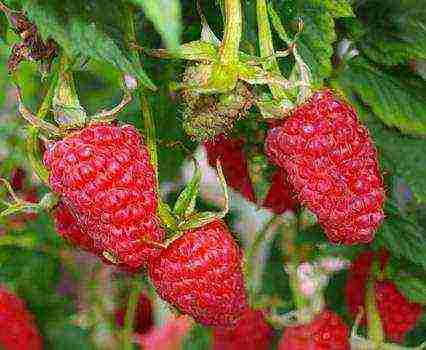 Large-leaved raspberry Moscow giant is classified as semi-renovated. The modern variety of large-fruited berries is a tall (more than 2 m) bushes. 8 or more shoots are formed from the roots. It is recommended to fix weak stems on a support so that they do not break under the pressure of the harvest. And this is possible, since the abundance of berries can exceed 10-12 kg per plant. Dark red fruits of elongated ribbed shape, glossy, juicy. The mass of one berry is about 25 grams. The taste is sweet, the amount of acid is minimal. Good disease resistance. Frost resistance - medium. Plantings can be saved by fixing them closer to the soil, where they overwinter under a snow "blanket".
Large-leaved raspberry Moscow giant is classified as semi-renovated. The modern variety of large-fruited berries is a tall (more than 2 m) bushes. 8 or more shoots are formed from the roots. It is recommended to fix weak stems on a support so that they do not break under the pressure of the harvest. And this is possible, since the abundance of berries can exceed 10-12 kg per plant. Dark red fruits of elongated ribbed shape, glossy, juicy. The mass of one berry is about 25 grams. The taste is sweet, the amount of acid is minimal. Good disease resistance. Frost resistance - medium. Plantings can be saved by fixing them closer to the soil, where they overwinter under a snow "blanket".
Domestic and foreign raspberries - the best varieties for a garden plot
Raspberry bushes of early and mid-early ripening period were bred by both Russian and foreign breeders.
Fruiting times vary, with the best early varieties starting to yield in June. It is more rational to simultaneously cultivate several different varieties of raspberries. First, it will make it possible to extend the harvest. Secondly, for this crop, cross-pollination only improves yield and quality indicators, and increases the life of fruiting bushes.
Raspberry Meteor and Solnyshko - from Russian breeders
 A brief description of the Meteor raspberry variety appeared after being included in the State Register in the second half of the 20th century. The harvest begins at the zenith of July and lasts about 2 weeks. Maturation is amicable. Berries from 2.5 to 4.5 grams, conical shape. The taste is sweet and sour, the color is bright red. The low stems on which the Meteor raspberry grows reach a height of two meters, with a small number of thorns. They are compact and do not fall apart. A plant with good immunity. The recommended replacement for new bushes is from the third year.
A brief description of the Meteor raspberry variety appeared after being included in the State Register in the second half of the 20th century. The harvest begins at the zenith of July and lasts about 2 weeks. Maturation is amicable. Berries from 2.5 to 4.5 grams, conical shape. The taste is sweet and sour, the color is bright red. The low stems on which the Meteor raspberry grows reach a height of two meters, with a small number of thorns. They are compact and do not fall apart. A plant with good immunity. The recommended replacement for new bushes is from the third year.
In the State Register, a description of the Solnyshko raspberry variety appeared in the nineties of the last century. It is classified as an early maturing species. The first berry picking is at the end of June. The plant is of medium height, from 1.5 to 1.8 m. The stems are strong, with a few unsteady thorns. The spread of shoots per square meter of area is from 15 to 20. Berries are 3-4 grams, round, slightly elongated. Color - burgundy red. Productivity from 1 to 2 kg per bush.Universal use due to the dense structure of berries with small seeds, sweet and sour taste and pleasant aroma.
Reward for Unpretentiousness - Widespread
 Domestic raspberry The award was bred by Russian scientists for industrial cultivation in the middle zone of the country. It is characterized as a mid-early species, with the beginning of fruiting in early July. A detailed description of the raspberry variety The award is familiar to gardeners in the vast majority of regions. Popularity is won due to the combination of the unpretentiousness of the plant, coupled with good harvesting ability. From one bush, you can get from 2.5 to 3 kg of cone-shaped red berries. The mass of one is 3-4 grams, the taste is excellent. The plant is medium-sized, about 200 cm. The stems are strong, the leaves are large, slightly wrinkled. Thorns are concentrated at the bottom of the shoots. During the season, from 4 to 8 new shoots appear, suitable for transplanting. The plant bears fruit for several years.
Domestic raspberry The award was bred by Russian scientists for industrial cultivation in the middle zone of the country. It is characterized as a mid-early species, with the beginning of fruiting in early July. A detailed description of the raspberry variety The award is familiar to gardeners in the vast majority of regions. Popularity is won due to the combination of the unpretentiousness of the plant, coupled with good harvesting ability. From one bush, you can get from 2.5 to 3 kg of cone-shaped red berries. The mass of one is 3-4 grams, the taste is excellent. The plant is medium-sized, about 200 cm. The stems are strong, the leaves are large, slightly wrinkled. Thorns are concentrated at the bottom of the shoots. During the season, from 4 to 8 new shoots appear, suitable for transplanting. The plant bears fruit for several years.
Raspberries from Poland and Canada: fruitful varieties
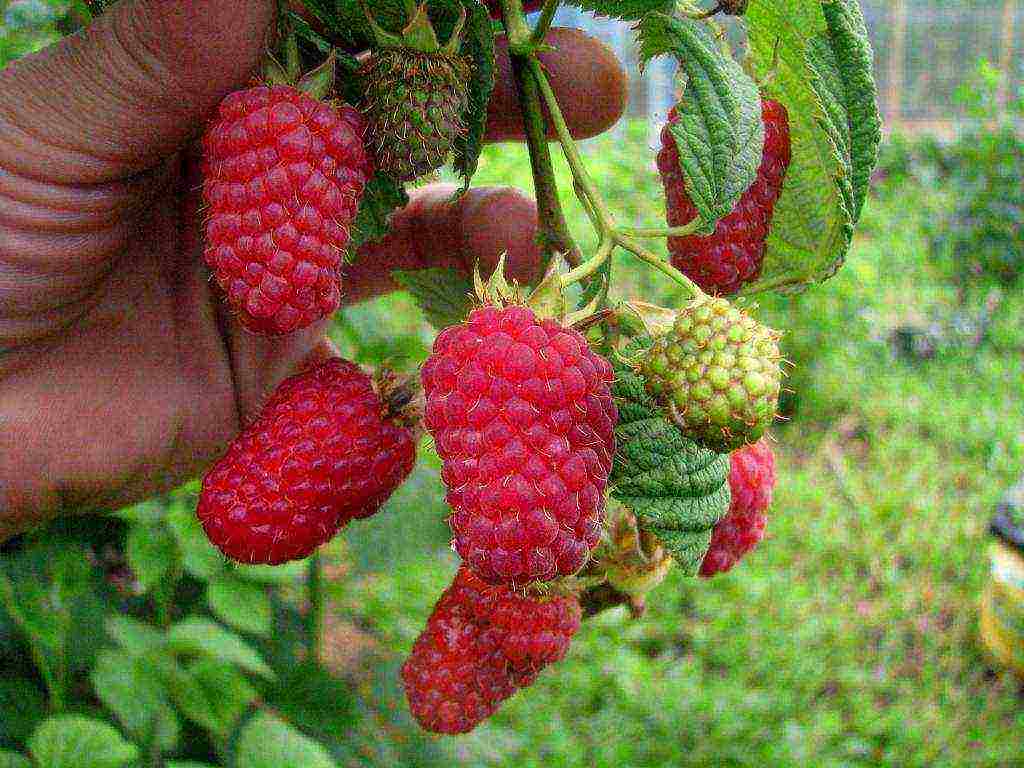 The register of early maturing contains a description of the Lyashka raspberry variety, originally from Poland. The large-fruited species belongs to the ultra-early ripening, the first berries ripen at the end of June. The local name of the variety is Lyachka. Tall shoots exceed the 2 meter mark and slope from the abundance of cylindrical fruits. The stems are provided with a large number of thin thorns. The mass of one berry is from 6 grams or more. Color - dull red, there is a slight pubescence. Productivity - from 3 kg per plant. They begin to bear fruit in the second year after planting in the ground.
The register of early maturing contains a description of the Lyashka raspberry variety, originally from Poland. The large-fruited species belongs to the ultra-early ripening, the first berries ripen at the end of June. The local name of the variety is Lyachka. Tall shoots exceed the 2 meter mark and slope from the abundance of cylindrical fruits. The stems are provided with a large number of thin thorns. The mass of one berry is from 6 grams or more. Color - dull red, there is a slight pubescence. Productivity - from 3 kg per plant. They begin to bear fruit in the second year after planting in the ground.
Since 1989, the description of the raspberry variety Tulamin of Canadian selection has become known to Russian gardeners. The plant begins to delight in the middle late period of ripening with fruits from the second year of growth. Berries in the form of a truncated cone, from 6 grams. The color is purple-red. The taste is sweet. Productivity from 2 to 4 kg per bush. Raspberry Tulamin plant is medium-sized, about 200 cm. The number of thorns is moderate. Leaves are glossy, slightly wrinkled. Good ability to form new shoots. Resistant to gray mold and spotting. The disadvantage is poor frost resistance. In most regions of Russia, it needs additional insulation for the winter. Bears fruit from 5 to 7 years. It is rational to periodically partially renew plantings to improve varietal qualities.
Raspberry seedlings quality standards
You can grow seedlings for new bushes with your own hands.
For this, young shoots are left at the most productive and healthy plants. In the market and in the store, you can buy modern views and improved versions of old acquaintances. Going for planting material, you should get acquainted not only with what varieties of raspberries are the most productive, but also with the requirements we are looking for young seedlings according to world standards:
we are looking for young seedlings according to world standards:
- young shoots should be fresh and flexible in appearance and to the touch, without mechanical wounds or damage;
- in the root part, the shoot should be about 1 cm in diameter;
- even the slightest signs of virus disease, insect damage are not allowed;
- a young plant with an open root system is sold as a shoot shortened to half a meter without leaves;
- a shoot with a closed root system is allowed for sale without shortening, with leaves.
All species, including mid-early raspberry varieties, can be planted 2 times a year, in spring and autumn. Repaired varieties will delight with berries in the current season, the rest - only in the second year.
A medicine and a treat for the flu and cold season is the main advantage of raspberry berries
Having set aside a small area on your site for planting raspberries of different varieties, you can grow a sufficient number of dessert and healthy berries for fresh consumption, in jam, in compote. Fresh frozen fruits do not lose their properties even after long-term storage, in winter they will serve not only as a delicacy, but also as an excellent remedy for high temperatures for the whole family.Check out the article: Raspberry Glen Ample is a productive variety for home and industrial cultivation.
Repaired raspberry varieties are gradually gaining popularity among domestic gardeners. They are distinguished by their unpretentiousness, high productivity and resistance to diseases. We have selected varieties that have held the title of the best of the best for several years.
One of the most popular garden berries is raspberry. In the CIS, preference is still given to traditional varieties, although, for example, in Europe, Canada and the United States, up to 90% of plantings are remontant varieties. Their main difference is that they begin to bear fruit in the first year and allow you to harvest a bountiful harvest twice a season - in summer and autumn. Since most of the remontant raspberries come from warmer countries, in the middle lane, before the onset of cold weather, the berry simply does not have time to fully ripen. Recently, however, Russian breeders have bred varieties with a short growing season specifically for the northern regions. We managed to select the best varieties of both foreign and local origin.
Apricot
This is one of the most exotic varieties of raspberries. Although the bushes grow small, they nevertheless need a garter. The berries ripen on them are medium-sized and neat, yellow in color with a pinkish tinge, they are easily separated from the fruit. The shape of the raspberry is blunt-conical, the taste of the berries is reminiscent of apricot. The plant is practically resistant to diseases and pests. Connoisseurs especially recommend making jam of bright amber color from this raspberry.
| Appointment | Productivity (kg per bush) | Berry weight (g) | Bush height (m) | Maturation (period) | |
|
2,5-3,5 |
3-4 |
1,3-1,5 |
Early August - late October |
||
Indian summer
This is the first sort of remontant raspberry bred in Russia. Designed for cultivation in the southern and central regions. The bush is sprawling, rather tall and erect. Berries of medium size, round-conical or spherical in shape. With the onset of ripeness, they acquire a dark crimson color. The taste is sweet and sour, but without a pronounced aroma. The pulp is tender and juicy, no frills. The variety is distinguished by winter hardiness, sometimes the plant is attacked by spider mites, powdery mildew disease and purple spot.
| Appointment | Productivity (kg per bush) | Berry weight (g) | Bush height (m) | Maturation (period) | |
|
1-2 |
3-4 |
1,8-2 |
Early June - early July. Early September - mid October |
||
Bryansk jubilee
A repaired early fruiting variety. The bushes are compact, with weak branching. The berries are not very large, beautifully elongated, bright red, sweet and sour. Under suitable conditions, fruiting begins in late July and then resumes in the fall. Productivity and, importantly, crop safety are at a high level. Disease resistance is average, the plant requires regular care, timely watering and feeding.
| Appointment | Productivity (kg per bush) | Berry weight (g) | Bush height (m) | Maturation (period) | |
|
2-3 |
3-4 |
1,2-1,4 |
Mid July - mid September |
||
Hercules
"Bryansk Bogatyr" is perfectly adapted to the climatic conditions of the middle zone. This variety is suitable for both domestic and industrial cultivation. The second wave of fruiting occurs closer to autumn, when the pests are no longer so active. Berries of intense ruby color with dense juicy pulp are similar to a truncated cone. Their taste is pleasant, sweet and sour. The variety is resistant to most fungal diseases, including gray mold. For the winter, it is advisable to cover the bush so that it does not freeze.
| Appointment | Productivity (kg per bush) | Berry weight (g) | Bush height (m) | Maturation (period) | |
|
2,5-3,5 |
5-7 |
1,5-2 |
Mid June. Mid August - early October |
||
Eurasia
A large-fruited variety, belongs to the standard varieties and at the same time is absolutely not picky about the composition of the soil and climate. An upright bush reaches a height of 1.5-1.6 m, so it is very convenient to pick berries from it.They are dark ruby in color, conical in shape, can be stored for a long time without loss of marketability. Raspberries taste sweet, but not sugary, but with a slight sourness and traditional raspberry aroma. The plant is quite resistant to all sorts of misfortunes, including temperature changes and pest activity.
| Appointment | Productivity (kg per bush) | Berry weight (g) | Bush height (m) | Maturation (period) | |
|
2-3 |
3,5-4,5 |
1,5-1,6 |
August - mid September |
||
Yellow giant
This type of raspberry is sometimes called the best variety for the middle lane. The bush has decorative properties, blooms very beautifully and bears fruit, so this raspberry in itself is a decoration of the garden. Neat yellow berries are useful for people with weakened immunity, allergy sufferers and pregnant women. They do not crumble from the bush for a long time and are perfectly stored. The plant has high frost resistance and is practically not afraid of various diseases.
| Appointment | Productivity (kg per bush) | Berry weight (g) | Bush height (m) | Maturation (period) | |
|
4-6 |
5-8 |
1,7-2 |
Mid July - mid October |
||
Golden domes
High-yielding variety of Russian selection. The bush is medium-sized, spreading, consists of 5-6 drooping shoots with small thorns. The berries are rather large, round-conical in shape and bright yellow in color, which later changes to apricot. The pulp is juicy, sweetish dessert, with an almost imperceptible raspberry aroma. The plant is resistant to the vast majority of diseases and is almost not attacked by pests. For the winter, it is advisable to leave only the rhizome, removing the entire aerial part.
| Appointment | Productivity (kg per bush) | Berry weight (g) | Bush height (m) | Maturation (period) | |
|
2-4 |
5-6 |
1,3-1,5 |
End of June - beginning of July. August - mid-October |
||
Polka
This is one of the most popular European varieties, the leader in yield among remontant raspberries. The bushes are practically devoid of thorns, so you can eat fresh raspberries without fear of scratching your hands. By the way, berries are the main advantage of this variety. They are beautiful, large, shaped like a thimble. The berries taste sweet, but not sugary; they are considered the standard of dessert taste. The plant is practically not susceptible to any type of disease. But what is contraindicated for bushes is heat and severe frost.
| Appointment | Productivity (kg per bush) | Berry weight (g) | Bush height (m) | Maturation (period) | |
|
2-3,5 |
5-6 |
1,5-1,8 |
End of July - beginning of October |
||
Ruby necklace
A high-yielding, transportable variety that is also suitable for industrial production. The bush is medium-sized, slightly spreading, with a small number of shoots. The berries are elongated, regular cylindrical, bright ruby color with a delicate sweet and sour pulp. At the end of fruiting, it is best to cut the aboveground part to ground level to avoid freezing of the plant.
| Appointment | Productivity (kg per bush) | Berry weight (g) | Bush height (m) | Maturation (period) | |
|
2-3 |
4-5 |
1,3-1,5 |
Mid August - mid October |
||
Elegant
This exquisite variety is appreciated by all lovers of a stable and abundant harvest. It is recommended for cultivation throughout Russia. A powerful bush is not prone to lodging, it grows no taller than human height. The berries are shiny, in the form of a wide obtuse cone, sometimes weighing up to 8 g. The taste is pleasant, the juicy pulp is sweet and sour. The plant practically does not get sick, the crop retains its presentation for a long time and is suitable for transportation over long distances.
| Appointment | Productivity (kg per bush) | Berry weight (g) | Bush height (m) | Maturation (period) | |
|
2,3-2,7 |
4-6 |
1,6-1,8 |
Early August - late September |
||
Repaired raspberry varieties are a real find for summer residents. These plants begin to bear fruit already in the first year, require minimal care, are slightly susceptible to diseases and pests, and at the same time yield up to 2 times a year. Try to plant at least one bush of remontant raspberries and you will not be disappointed.
All gardeners - professionals and amateurs are attracted by the large-fruited, high-yielding raspberry varieties and certainly with a delicious aroma and taste.
In Russia, this can be achieved by observing the rules of planting and care. From the proposed material, you can get acquainted with the raspberry varieties with photographs and descriptions that are distinguished by good yield, taste, winter hardiness and resistance to diseases and pests.
You need to know that the planting material is selected taking into account personal preferences, as well as the climatic conditions of a particular area.
Early raspberry varieties
There are many early types of raspberries, it is impossible and unnecessary to pay attention to each of them in one article.
Consider several varieties of frost-resistant, well-established in the middle lane. Of course, the most interesting are high-yielding, large-fruited, resistant to diseases, pests and drought.
Here are brief characteristics of early raspberry varieties with descriptions and photographs: Here are the traditional raspberry varieties - "raspberry" color. About the ripening time of yellow, black, and remontant varieties - information in the relevant sections of the article.
So:
Bryansk cascade

Medium spreading bushes of medium height also give berries of medium weight - up to 2.5 g of a blunt rounded shape (pictured above).
The variety does not require special care, but the yield is good, with a standard planting scheme - up to 1 kilogram per 1 m2.
Balm
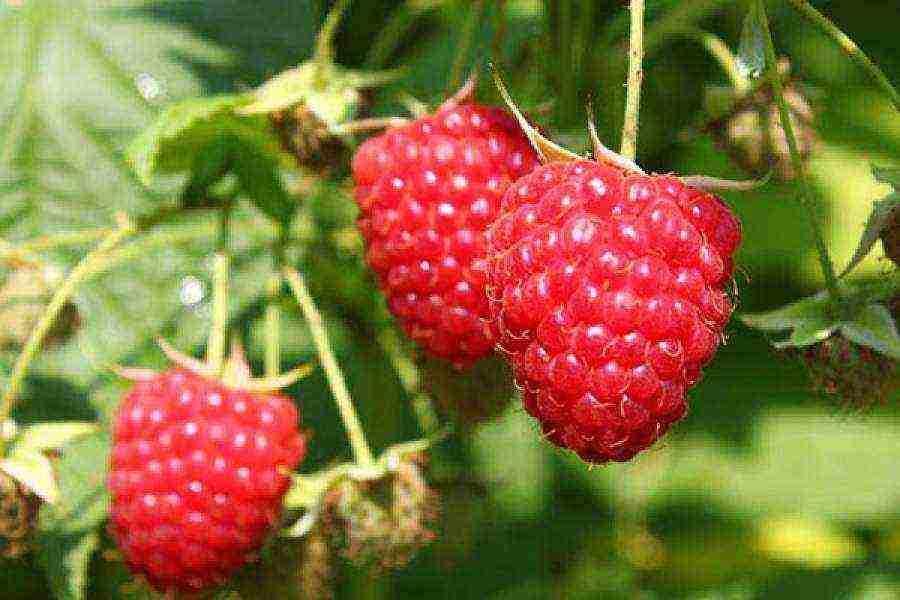
Shoots up to 2 meters high with a waxy bloom, low prickly, berries weighing 2.5-3 g, dark shade. Yields a yield of 0.6-0.8 kg per 1m2. The variety is not afraid of spider mites and purple spot.
Novokitaevskaya

The variety was entered in the State Register in 1974, obtained by crossing the varieties Kitaevskaya and Novost Kuzmina. If you pay due attention to Novokitaevskaya raspberries on your site, then the yield can be raised to 4 kg from one bush. Blunt-pointed berries weighing up to 2.5 g have good consumer qualities.
Meteor
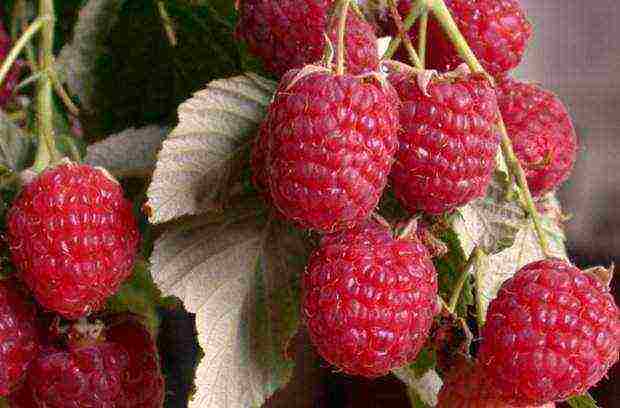
The early variety among the early ones, obtained as a result of crossing the raspberries Kostinbrodskaya and Novost Kuzmina. Berries weighing up to 3g. Harvest from one bush - 1.5-3 kg of sweet and sour fruits. Resistant to raspberry mites and major fungal diseases, and from spider mites requires timely protection.
Mid-season varieties
Gardeners have the same wishes (or requirements) for raspberry varieties of medium ripening periods as for everyone else - high yield, frost resistance, etc.
The average ripening period of raspberries is a rather loose concept, because the same variety can be planted in different climatic conditions - this is, firstly.
Secondly, summer weather in any year can bring its own surprises, which can "shift" the ripening phase of berries according to the "usual" timing.
Thirdly, the agricultural technology used, the wishes and capabilities of the gardener - can also affect the timing of fruiting. In a word, as in the famous funny book - the rescue of drowning people, the work of the drowning people themselves.
While early varieties of raspberries usually satisfy appetite, mid-ripening berries are mostly processed into compotes and jams.
These are the following varieties that provide good yields:
Reward
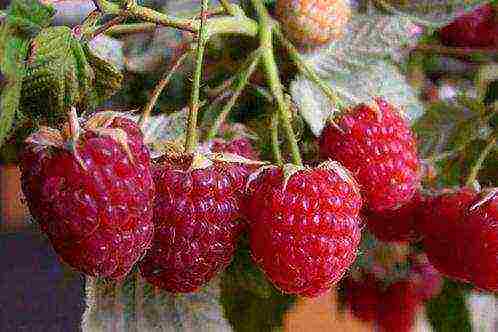
Tall bushes that do not require garters on trellises yield up to 3 kg of tasty, sweet and sour, blunt-pointed fruits weighing up to 3.5 g; The variety was obtained in the early 70s by crossing raspberries Kolkhoznitsa and Lloyd George, and is still loved by gardeners in the middle lane.
Balm
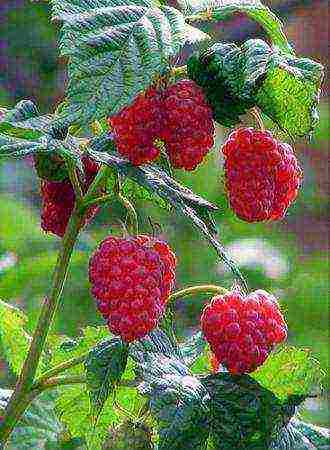
Ideal berry (2.5-2.8 g) for homemade preparations. Shoots reach a height of 1.8 m, their yield is higher than average - 2.2 kg from a bush. Derived from Newburgh and Rubin Bulgarian varieties. Good winter hardiness. The variety is included in the State Register of most Russian regions.
Zorenka Altai
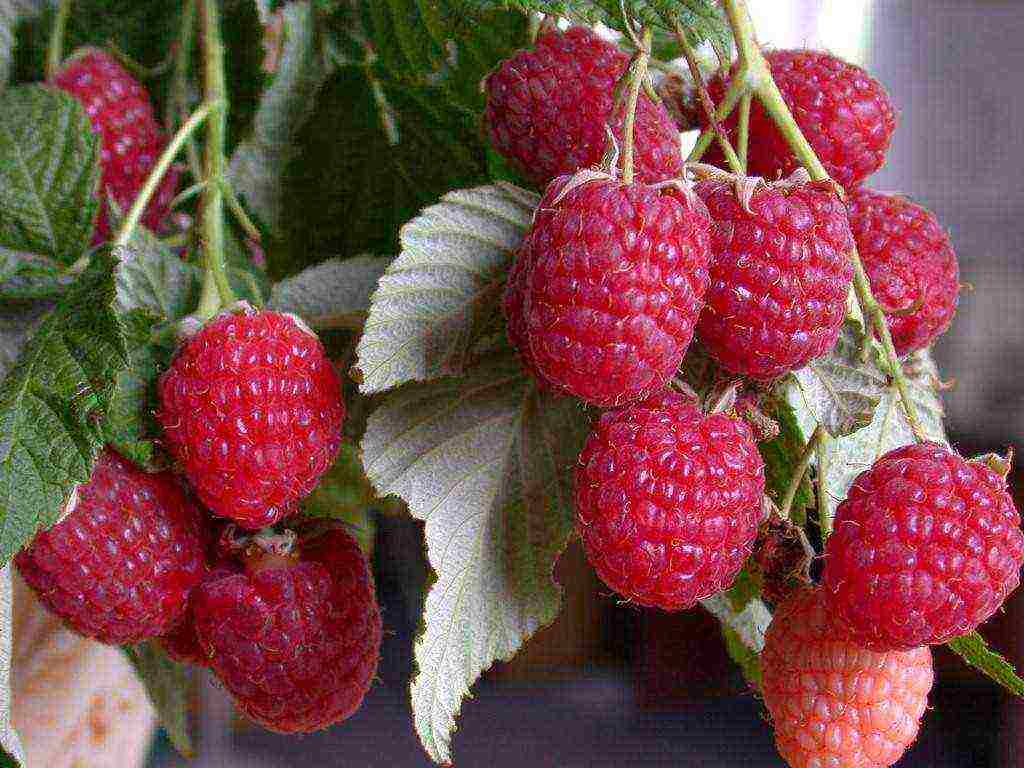
It is characterized by a sweet-sour taste of berries weighing up to 3 g. A tall, medium-spreading bush does not have a high yield. The originator of the variety is the Siberian Research Institute of Horticulture. The variety is obtained by natural pollination of wild berries and Viking raspberries.
Modest

Erect shoots of low "growth" tolerate frosts well, but react painfully to drought. Conical berries, weighing up to 3 g, dark shade, with a weak aroma, yield 2.2 kg per bush. The "parents" of the Shy ones are the Ottawa and Rubin varieties.
Giant
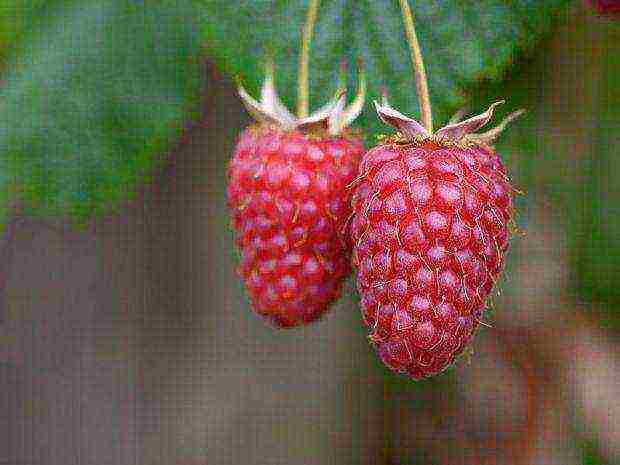
The name of the variety speaks of large fruits (up to 18 g) and high yield - 5-6 kg of sweet and sour, oblong, dense berries can be removed from the bush. The variety is also called the Pride of Russia, and it fully justifies itself. In the northern region, it is recommended to cover the shoots for the winter.
Late ripening varieties
Late varieties are good because in a peculiar way they remind of warm summer days.
These varieties completely replace remontant ones, if the gardener does not have an attachment to this type:
Brigantine
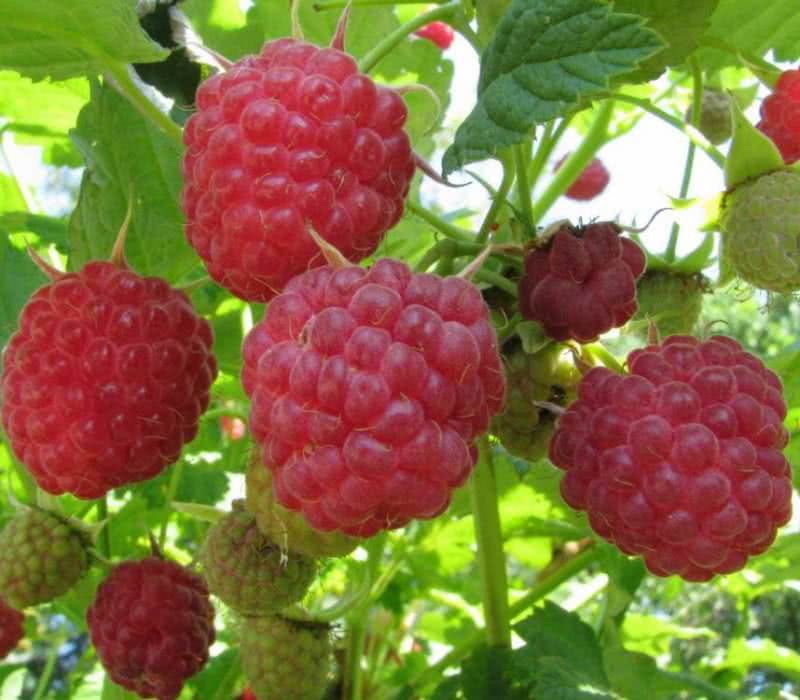
It tolerates severe frosts with sufficient snow cover. Good yield for home cultivation - 2.2 kg per plant. The berries are round, slightly conical, weighing up to 3 g, suitable for transportation. The variety was bred by crossing the Sayana and Ottawa varieties.
Mirage
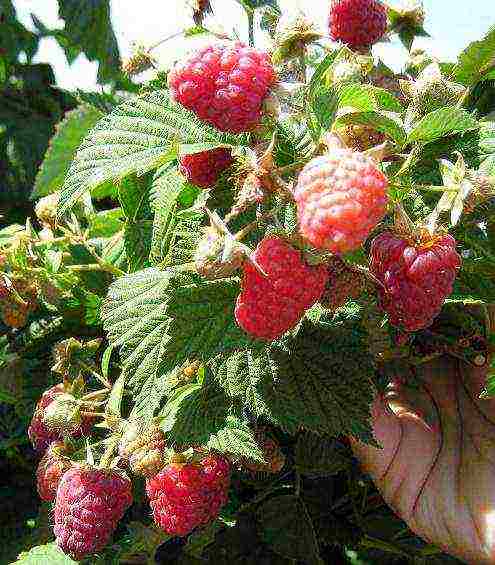
A high-yielding variety, gives 4 kg of berries weighing 5-6 g per bush, tall (up to 2.5 m), medium winter hardy, the stems with a waxy bloom are covered with thorns. High transportability of fruits.
Companion
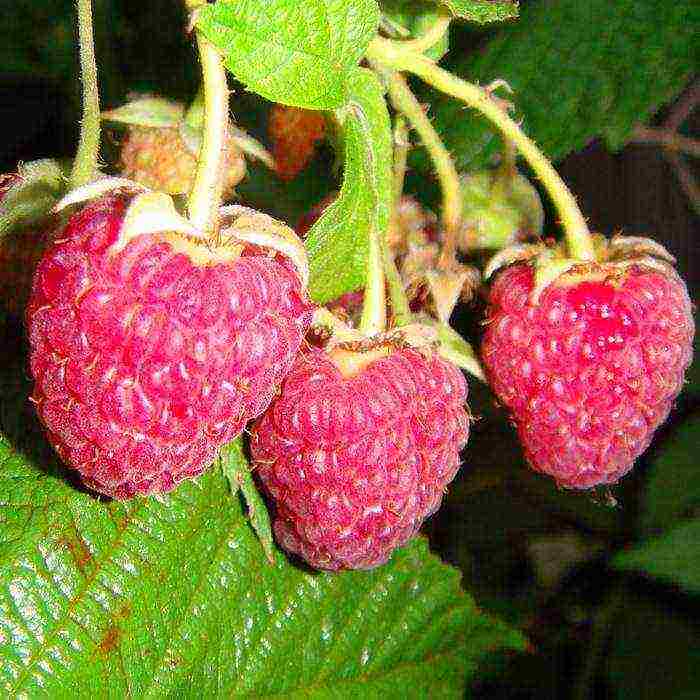
In the fall, the attentive gardener will give up to 2 kg of dark, blunt-conical, vitamin C-rich berries weighing 2.5 - 3.0 g from one bush. The dense texture of the fruit makes them transportable. There is no wax coating on the shoots, but there are enough thorns.
Repair plants
The advantage of the remontant type of raspberry is that it is less susceptible to diseases and pests than summer raspberries, and does not require constant chemical treatments. Repaired raspberry varieties have an increased need for sunlight and warm fertile soil. Well-lit areas are desirable for planting a remontant variety; a small shade can significantly reduce the yield.
The success of growing remontant raspberries can be indicated by the following rule - the more heat and sun, the better. This is especially true for the Leningrad region - a territory with a transitional continental to maritime climate.
For planting raspberries, you need to select places protected by buildings, bushes, trees from cold northern winds.
Before laying a raspberry tree, it will not be superfluous to conduct a competent analysis of the soil in a specific area.
In the North-West of Russia, high-yielding remontant varieties have proven themselves well:
Unattainable
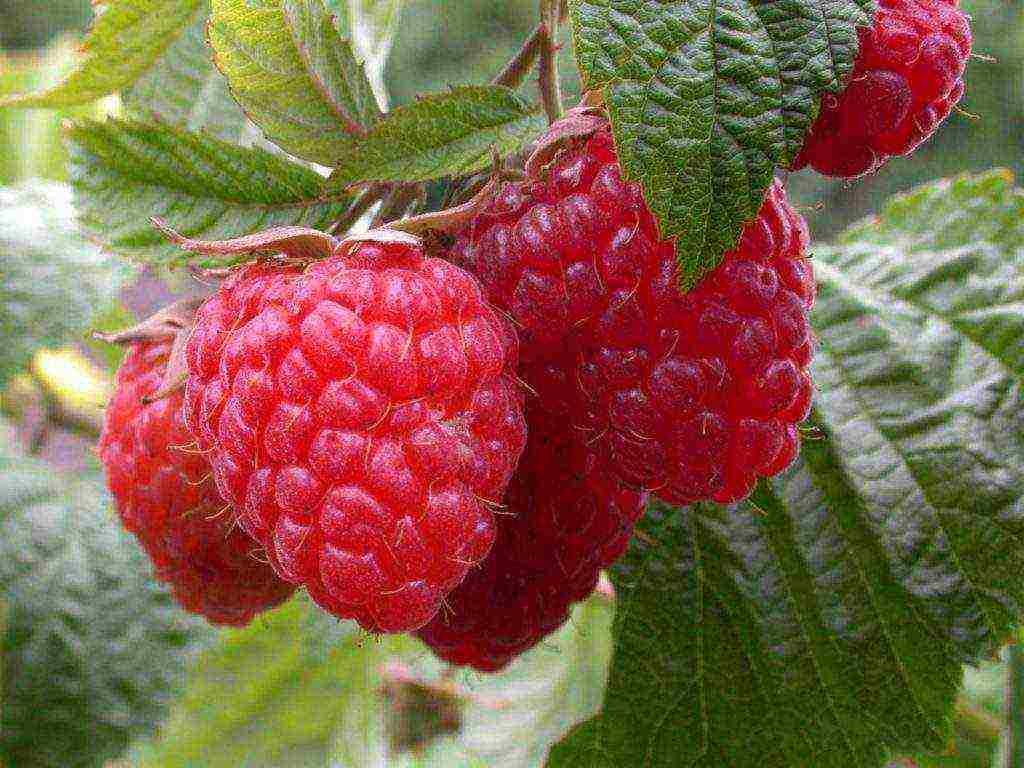
The berries ripen before the start of frost - in mid-September. Their weight is from 3 to 6 g, dark red, uniform, medium density. Fruits with a delicate "raspberry" aroma, few seeds, perfectly removable from the fruit-bearing, transportable. The average yield per bush is 2.5-3 kg, but it can be doubled with careful care. Ripening - from early August to mid-September.
Kalashnik

The characteristics of the variety are almost the same as the Inaccessible Raspberry. Plants up to 2 meters high, powerful, spreading, form up to 12 replacement shoots and up to 10 root suckers. Productivity - more than 2 kg of berries weighing 3.5 g;
The yellow Orange miracle also belongs to the remontant varieties, which will be mentioned below.
Yellow raspberry
In the middle lane, the berry is not as popular as the traditional red one, although the cultivation methods are the same as the agricultural technology of the scarlet's relative. Many gardeners argue that the taste of yellow raspberries is even higher, but as they say: to taste and color. ... This type of raspberry is used in landscape design - the bushes lend themselves well to forming and grow "in moderation."
Advantages:
- Diet product.
- Useful for people with allergies.
- A good combination of sugars and acids.
- Blanks from yellow raspberry are obtained with excellent color.
- Yellow berry varieties tolerate cold weather better.
- This species does not mature at the same time - the period of fresh consumption is rather long.
There are also disadvantages - low transportability, unsuitability for winemaking and freezing for long-term storage.
Gardeners unanimously call the best varieties of yellow raspberries of the middle lane:
Yellow giant
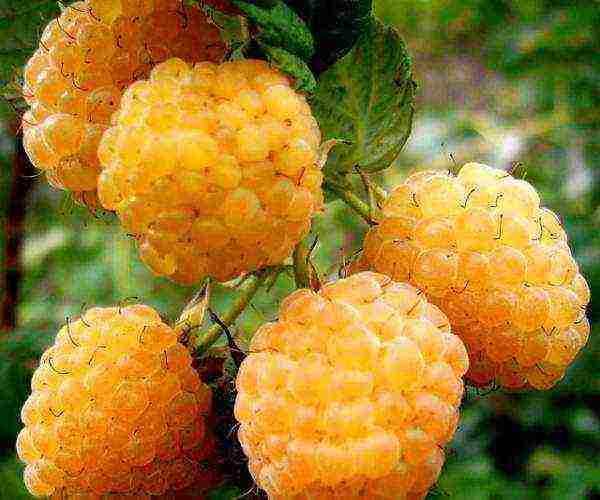
Fruits weighing up to 3.5 g, high-yielding variety (up to 10 kg per bush), disease-resistant, slightly frost-resistant. Shoots grow up to 2.5 m, in winter they need shelter under the snow.
Orange miracle
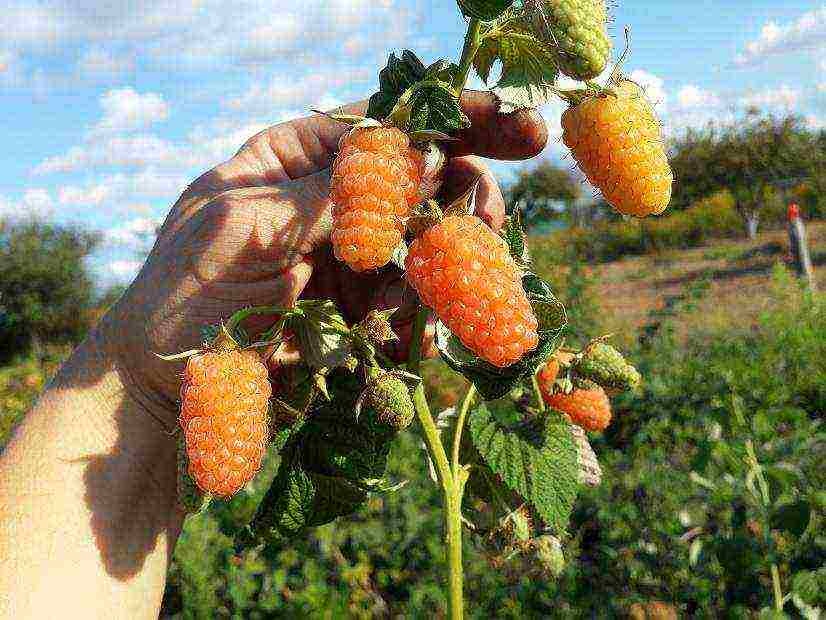
The name of the remontant variety is true. Long and dense, weighing up to 6g, berries are perfectly transported, from one small bush with many thorns, more than 2 kilograms of berries are removed. It is recommended to tie the plant up.
Runaway
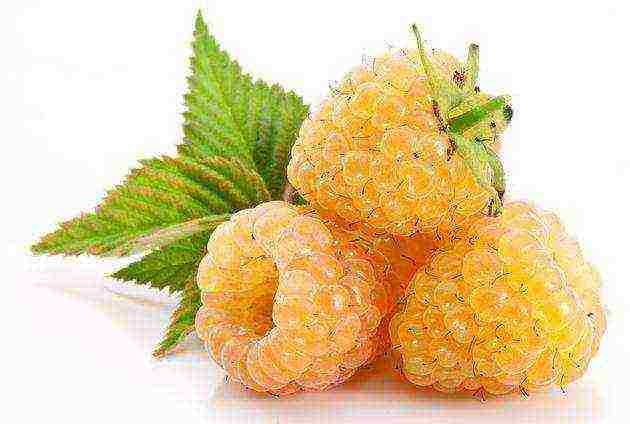
Medium height, up to 2 meters, slightly spreading bush, straight shoots, almost no thorns. Berries of apricot color, weighing up to 3 g, have a delicate aroma and taste. The yield of the variety is 2.5 kg from one plant. The disadvantage is poor transportability.
Golden autumn
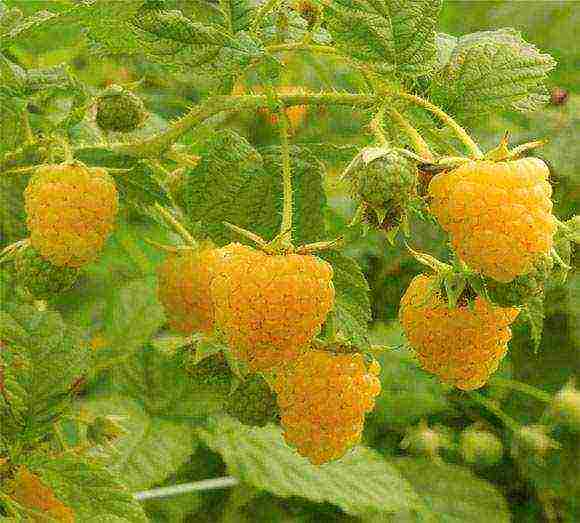
Repaired large-fruited (up to 7g), beautifully shaped, dense, with a delicate raspberry aroma. The name "Golden Autumn"? In the Leningrad region, the autumn harvest from a bush is 2.5-3 kg.
Black varieties
This type of raspberry is less common in the Middle lane due to its dubious frost resistance. However, experienced gardeners claim that by paying a little more attention to black raspberries, they will reward them with a bountiful harvest, much more significant than traditional varieties.
In appearance and description, the berry is similar to a blackberry. It is easy to check which plant it belongs to. If it comes off with a receptacle - a blackberry. The receptacle remained on the bush - raspberries.
Black raspberry bushes are decorative, they are strewn with berries of red, pink, black color during ripening, they serve as an excellent decoration of a garden plot or a flower bed.
Northwest growers prefer the American-bred Cumberland, which looks little different from other black varieties. Its peculiarity is its ability to reproduce vegetatively.
Other recognized middle lane varieties are:
Ember
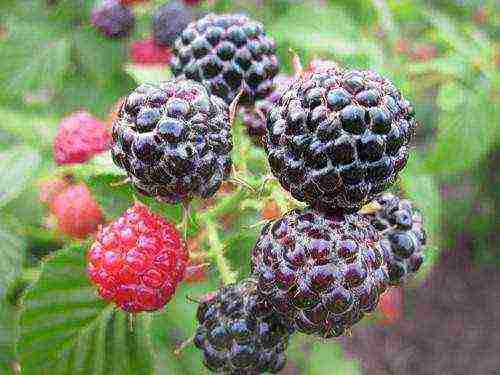
Early, with firm and sweet pulp, high-yielding, berries weighing 2 g. It tolerates frost well, is not afraid of diseases and insects. Productivity in the range of 1.5 - 2.0 kg per plant;
Airlie Cumberland

Early maturing, similar to Cumberland in many ways. Berries are black, weighing 1.6 g of a sugary sweet taste, they are not pecked by birds. The yield is high;
Bristol
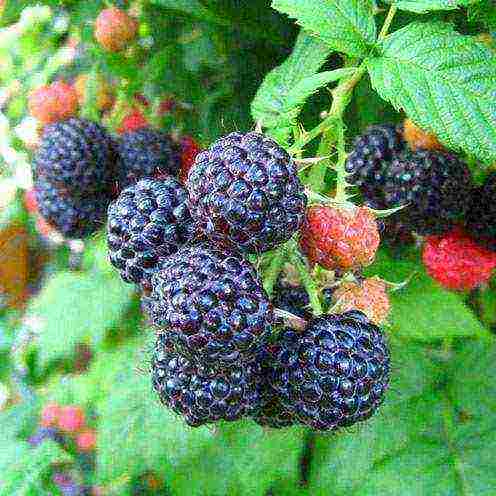
A late variety of black raspberries, considered one of the best varieties, large-fruited, sweet berries, recognized by our gardeners as high-yielding. The disadvantage is that it does not tolerate winter cold.

